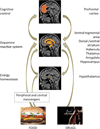Obesity and addiction: neurobiological overlaps
- PMID: 23016694
- PMCID: PMC4827343
- DOI: 10.1111/j.1467-789X.2012.01031.x
Obesity and addiction: neurobiological overlaps
Abstract
Drug addiction and obesity appear to share several properties. Both can be defined as disorders in which the saliency of a specific type of reward (food or drug) becomes exaggerated relative to, and at the expense of others rewards. Both drugs and food have powerful reinforcing effects, which are in part mediated by abrupt dopamine increases in the brain reward centres. The abrupt dopamine increases, in vulnerable individuals, can override the brain's homeostatic control mechanisms. These parallels have generated interest in understanding the shared vulnerabilities between addiction and obesity. Predictably, they also engendered a heated debate. Specifically, brain imaging studies are beginning to uncover common features between these two conditions and delineate some of the overlapping brain circuits whose dysfunctions may underlie the observed deficits. The combined results suggest that both obese and drug-addicted individuals suffer from impairments in dopaminergic pathways that regulate neuronal systems associated not only with reward sensitivity and incentive motivation, but also with conditioning, self-control, stress reactivity and interoceptive awareness. In parallel, studies are also delineating differences between them that centre on the key role that peripheral signals involved with homeostatic control exert on food intake. Here, we focus on the shared neurobiological substrates of obesity and addiction.
© 2012 The Authors. obesity reviews © 2012 International Association for the Study of Obesity.
Conflict of interest statement
No conflict of interest statement.
Figures



Comment in
-
Is food addiction a valid and useful concept?Obes Rev. 2013 Jan;14(1):19-28. doi: 10.1111/j.1467-789X.2012.01046.x. Epub 2012 Oct 12. Obes Rev. 2013. PMID: 23057499 Free PMC article.
References
-
- Volkow ND, O’Brien CP. Issues for DSM-V: should obesity be included as a brain disorder? Am J Psychiatry. 2007;164:708–710. - PubMed
-
- Volkow ND, Wang GJ, Fowler JS, Tomasi D, Baler R. Food and drug reward: overlapping circuits in human obesity and addiction. Curr Top Behav Neurosci. 2011;11:1–24. - PubMed
-
- Spear HB. The growth of heroin addiction in the United Kingdom. Br J Addict Alcohol Other Drugs. 1969;64:245–255. - PubMed
-
- Goldstein A. Addiction: From Biology to Drug Policy. 2nd. New York: Oxford University Press; 2001.
Publication types
MeSH terms
Substances
Grants and funding
LinkOut - more resources
Full Text Sources
Other Literature Sources
Medical

